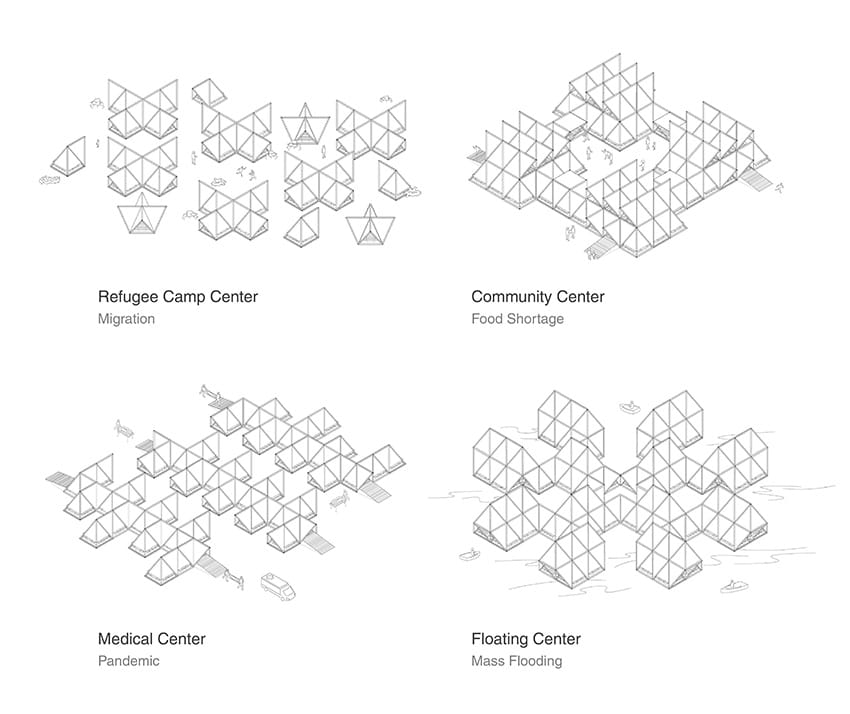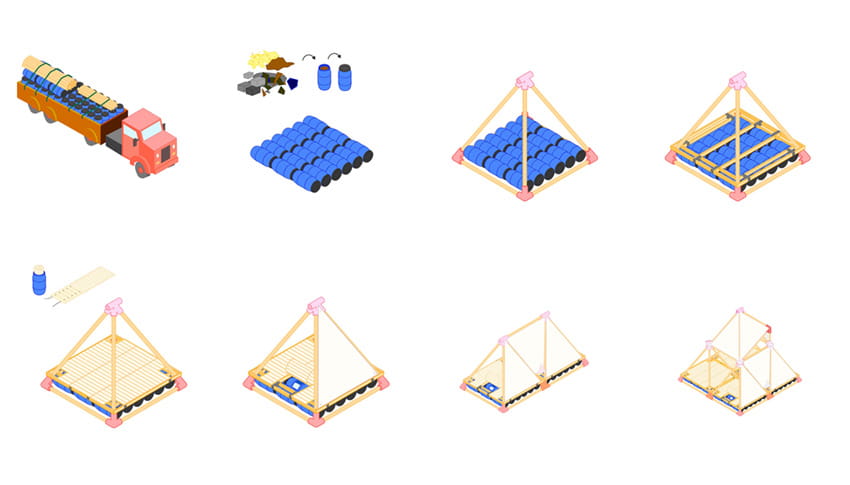
TU Delft students create Ponya - a modular system for disaster-struck communities
TU Delft students Francisca hamilton, Nathan Ngo and Thanat Prathnadi has designed a modular system as a singular design solution for disaster-struck communities within Sub-Saharan Africa called Ponya. The system is designed for a multitude of emergency scenarios ranging from natural disasters to social conflicts. Based on triangular geometry, the form of these shelters could become highly adaptable based on the 4S system: scenario, site, scale and schedule.
The human-centric approach to Ponya begins with the scale of the singular module, being large enough to shelter a family of six, yet low enough to encourage a sense of refuge. For the construction of an Emergency Operations Center (EOC), modules can be connected in all three-axes depending on the required capacity and program. Internally the division of spaces are created using ePTFE tarps and curtains, allowing programmatic flexibility based on the progress of a scenario.
Based on the structural integrity of a pyramid, the aesthetic is found in the flexibility and simplicity of a singular module. The representation of this is pronounced in the composition of three primary materials: blue plastic water barrels as the foundation, bamboo vulgaris as the structure and 3D printed PETG members as the joinery. The intention behind such simplicity is to ensure this system can be efficiently assembled, dismantled and reassembled without the use of power tools or machinery. This is made possible through the prefabrication of components at a regional warehouse, and the adoption of a supply system measured and transported by ‘the barrel’. The unpredictable nature of disasters is therefore reliant on abundant materials such as the blue barrels and bamboo vulgaris, and locally produced components such as the printed joinery and the canvas tarps.



The design and function of Ponya was derived from a low-tech objective. From the logistical point of view, the use of the blue barrels would simplify the process of transporting materials and supplies. The use of onsite debris, or the storage of food supplies in the barrels effectively forms the foundation of the structure. Internally, the triangular structure provides opportunities for elevated shelves and secure storage whilst the floor with its tensed slat structure can be rolled up in order to access the barrels below. When the EOC is in response to flooding, the barrels can be emptied and sealed, enabling the structure to float and keeping the interior dry. The onsite ‘construction’ is the assembly of pre-fabricated components. To lower the manufacturing costs and simplify the process, a maximum of fourteen component types are required to erect an EOC of any scale and form. Most noticeably, all bamboo members are of the same length, and the six different joinery members are colour coded depending on their placement. The EOC would rely solely on passive cooling, heating and ventilation through the manipulation of openings, double-height spaces, and overhangs.



Circularity occurs on the scale of the system and that of its components and materials. Ponya as a system has been designed with a temporal and adaptable objective. It can be repeatedly dismantled and reassembled in a different form for a different scenario. Utilizing components such as pre-used blue barrels that are no longer appropriate for storing drinking water, can be repeatedly used within Ponya. By investing in PETG filament printing, the joinery components can withstand harsh conditions without deforming and eroding in the socket areas. The use of ePTFE tarps as a durable heat-resistant and hydrophobic fabric can be repeatedly used despite varying conditions between sites. In addition, locally sourced bamboo vulgaris and caissadra timber for the flooring, fuels the local economies and reduces the Ponya’s net carbon footprint.
ABOUT
Thanat Prathnadi, Nathan Ngo and Francisca Hamilton are architecture students at TU Delft completing the final year of their Master's Degree. They are interested in combining local materials with new technologies to create systems that respond to surrounding environmental issues.
SUBSCRIBE TO OUR NEWSLETTER


IMAGE GALLERY
SHARE ARTICLE
COMMENTS